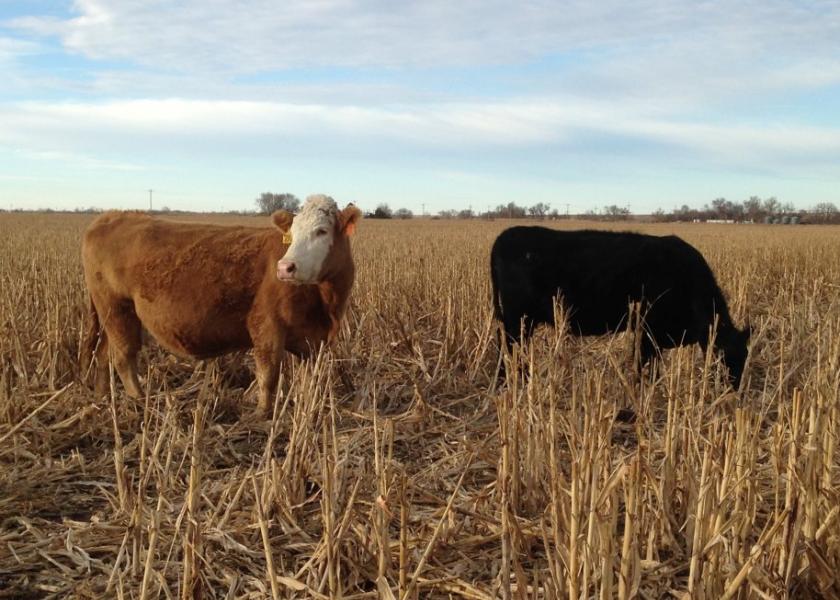Use Caution When Grazing Corn Residue

Corn residue can be a good option for extending the grazing season, but too much grain can cause digestive upsets and other health issues.
Corn residue can be a great option for beef producers to extend the grazing season, according to North Dakota State University Extension Service livestock experts.
Grazing corn residue typically is the most cost-effective method to take advantage of nutrients remaining in the field after combining.
“However, producers must evaluate individual fields and grazing scenarios, and make appropriate management plans to ensure cattle health,” beef cattle specialist Carl Dahlen says. “Cattle preferentially will consume grain and leaves before consuming lower-quality stalk material. This is an important consideration when developing strategies to graze crop residues.”
Producers need to be very cautious of piles of grain that spilled into fields during harvest and large amounts of downed ears remaining in fields. Recent wind storms in some areas of the state have left a significant amount of downed ears in fields.
In some cases, producers have reported up to 70 bushels of corn per acre remaining on the ground. In this extreme case, for each acre of field that cows can access, 3,920 pounds of corn remain. That is just less than 40 pounds of corn per acre for every 100 cows, says John Dhuyvetter, area livestock systems specialist at the North Central Research Extension Center near Minot.
In addition to downed ears, some of these fields have significant leaf loss due to the windy conditions, so little forage is available.
Consuming too much grain can cause digestive upsets (acidosis), lameness and abortions, and death in extreme cases. But not all issues will be observed right away. For example, founder will be seen during the course of several months as cattle’s hooves continue to grow and abscesses develop.
“Any time in which corn ear drop is greater than 8 to 10 bushels per acre, producers must develop a strategy to mitigate potential grain overload in cows,” says Karl Hoppe, area livestock systems specialist at the Carrington Research Extension Center. “Each 8-inch ear of corn contains roughly 1/2 pound of grain.”
To determine the amount of corn remaining in fields planted in 30-inch rows, count the number of 8-inch ears (or equivalent) on the ground along 100 feet between two rows, then divide the total by 2. Do this for at least three 100-foot-long strips in the field to get a good estimate of corn remaining in the field. See http://tinyurl.com/grasingcropresidue for more information.
Any grazing scenario with high amounts of spilled corn or downed ears presents risks to the cattle that are grazing. Here are several strategies Fara Brummer, area livestock systems specialist at the Central Grasslands Research Extension Center, suggests producers consider to help mitigate risk:
- Carefully consider the class of cattle allowed to graze cornstalks. Cattle new to eating corn (calves or yearlings) will take some time before they actively seek corn. This delayed consumption can serve as a good acclimation period. Cows with experience grazing corn aftermath will look for grain and downed ears immediately when turned out. Consider grazing calves, yearlings or cull cows on fields to clean up some of the corn before turning out pregnant cows.
- Provide some type of ionophore-containing supplement.
- Adapt cattle to corn before turning out to graze corn stalks. Start with 3 pounds daily and move up to 7 or 8 pounds during a 10-day period before turnout.
- Cross-fence fields to minimize the amount of the field that cows have access to at any one time. Early in the grazing period, this may mean moving the fence daily.
- Do not turn hungry cattle out to graze. Provide good-quality hay so cattle don’t overeat corn immediately. Also, set out bales of good-quality hay in corn fields so cattle have access to hay while grazing corn.
After cattle are past the initial risks posed by grain remaining in the fields, producers have several other management considerations. One of them is supplementation. Depending on the desired level of performance, producers should provide supplemental phosphorus, vitamin A and trace minerals once the grain and better-quality forage material have been consumed.
Also, closely monitor the amount of residue remaining on fields and provide supplemental forage or remove cows as necessary. Do not force cattle to eat stalks and cobs because they are low-quality feed.
Check out the NDSU publication “Utilizing Corn Residue in Beef Cattle Diets” for more information.
Source: NDSU Extension







